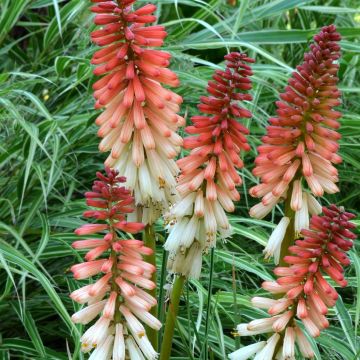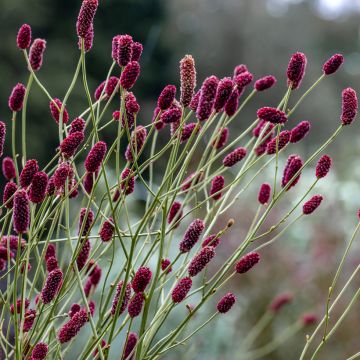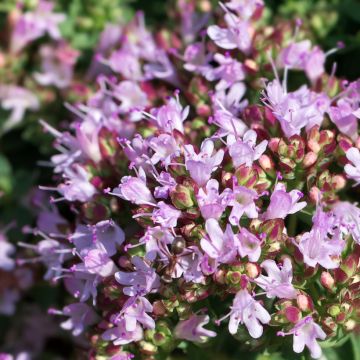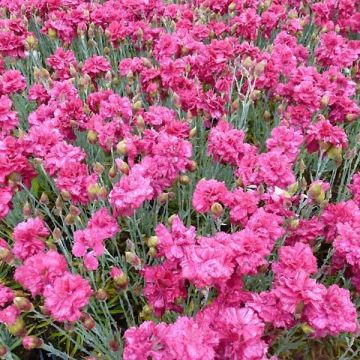

Macleaya cordata Flamingo


Macleaya cordata Flamingo


Macleaya cordata Flamingo
Macleaya cordata Flamingo
Macleaya cordata Flamingo
Plume Poppy
This item cannot be shipped to the selected country
Delivery charge from €5.90
More information
Schedule delivery date,
and select date in basket
This plant carries a 12 months recovery warranty
More information
We guarantee the quality of our plants for a full growing cycle, and will replace at our expense any plant that fails to recover under normal climatic and planting conditions.
From €5.90 for pickup delivery and €6.90 for home delivery
Express home delivery from €8.90.

Does this plant fit my garden?
Set up your Plantfit profile →
Description
Macleaya cordata 'Flamingo' is a superb variety of Plume Poppy, awarded in England for its ornamental qualities and performance in the garden. Even more decorative than the wild species, this voluptuous perennial with its airy flowers, seduces with its ample and lobed foliage in a soft grey-green and its magnificent summer flowering in creamy to peachy pink panicles, which fade beautifully. The plume poppy is perfect in the back of a bed, in association with other giant airy plants, in a natural garden.
Native to China and Japan and belonging to the Papaveraceae family (like poppies), Macleaya cordata is also known as "Plume poppy" among English speakers, due to the appearance of its flowers. It is a herbaceous perennial with a woody base and rhizomatous roots of great vigour. The plant spreads rapidly thanks to its trailing roots, which makes it suitable for large spaces. Flowering takes place in summer, in July-August, in the form of large feathery panicle inflorescences that persist for a long time on the plant. The flowers are tiny but numerous, and composed of two sepals forming a cream-white calyx, which then tints pale salmon or peachy pink. The stems of this plume poppy, covered with a whitish bloom, contain yellow latex. They bear large alternate leaves resembling those of heucheras or annual poppies, divided into 5 to 7 rounded lobes. The leaves are a pale gray-green colour. The plant easily self-seeds in moist soil, but does not always produce plants identical to the mother plant. The plume poppy is deciduous, its above-ground vegetation dies and dries in winter to re-emerge from the ground in spring. It is perfectly hardy, at least down to -15°C (5°F).
In the garden, this voluptuous perennial thrives in full sun, sheltered from strong winds, in ordinary but deep, well-drained, and moist soil. Its substantial growth is perfect for quickly creating beautiful volume at the back of a bed. In the garden, Macleaya cordata Flamingo can be placed on its own as its beauty is sufficient, or alongside other towering perennials with strong personalities such as Purple Eupatorium, Giant Bronze Fennel, or Gunnera manicata. It also looks stunning with Red Castor Oil Plant 'Carmencita', at the back of beds composed of more modest-sized perennials such as daylilies, peonies, hyssops, and echinaceas, for example.
Report an error about the product description
Macleaya cordata Flamingo in pictures


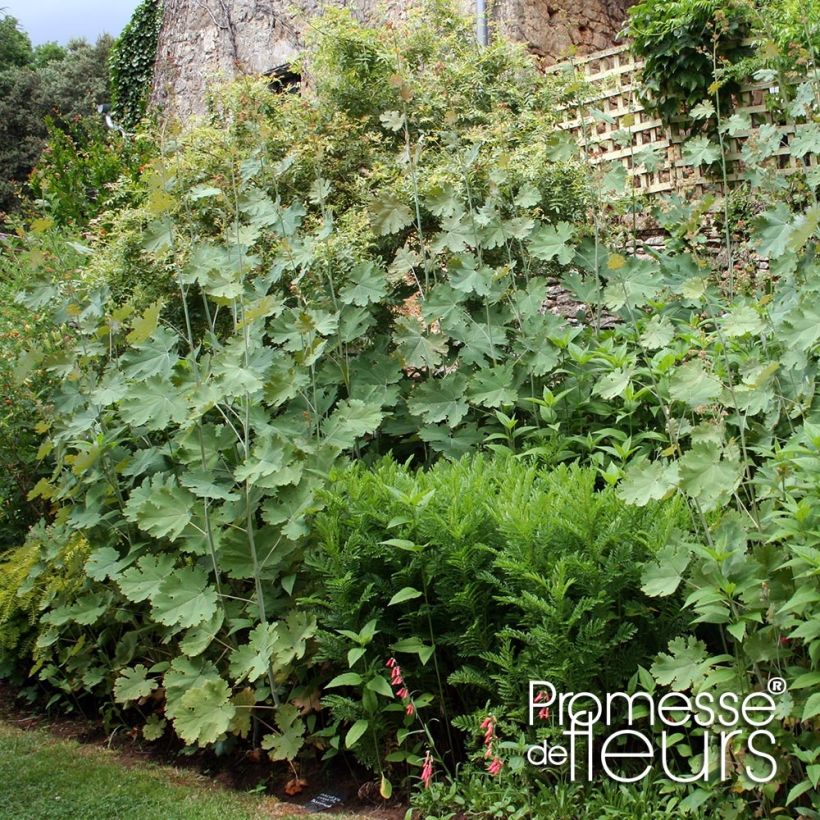

Flowering
Foliage
Plant habit
Botanical data
Macleaya
cordata
Flamingo
Papaveraceae
Plume Poppy
Cultivar or hybrid
Other Perennials A to Z
Planting and care
Macleaya cordata Flamingo thrives in a sunny and sheltered location, in a normal, moist, but well-drained soil. It requires space - at least 5 m² - for it to reach its full potential, as well as a rich and deep soil. This perennial can be susceptible to a fungal infection caused by Erysiphe macleayae, a powdery mildew that covers the leaves with white spots, which thrives in warm and humid conditions. It is when planted as a specimen, or in the company of other large plants such as giant petasites, e.g. Gunnera manicata, or bamboo, that it truly shines.
Planting period
Intended location
Care
-
, onOrder confirmed
Reply from on Promesse de fleurs
Summer flowering perennials
Haven't found what you were looking for?
Hardiness is the lowest winter temperature a plant can endure without suffering serious damage or even dying. However, hardiness is affected by location (a sheltered area, such as a patio), protection (winter cover) and soil type (hardiness is improved by well-drained soil).

Photo Sharing Terms & Conditions
In order to encourage gardeners to interact and share their experiences, Promesse de fleurs offers various media enabling content to be uploaded onto its Site - in particular via the ‘Photo sharing’ module.
The User agrees to refrain from:
- Posting any content that is illegal, prejudicial, insulting, racist, inciteful to hatred, revisionist, contrary to public decency, that infringes on privacy or on the privacy rights of third parties, in particular the publicity rights of persons and goods, intellectual property rights, or the right to privacy.
- Submitting content on behalf of a third party;
- Impersonate the identity of a third party and/or publish any personal information about a third party;
In general, the User undertakes to refrain from any unethical behaviour.
All Content (in particular text, comments, files, images, photos, videos, creative works, etc.), which may be subject to property or intellectual property rights, image or other private rights, shall remain the property of the User, subject to the limited rights granted by the terms of the licence granted by Promesse de fleurs as stated below. Users are at liberty to publish or not to publish such Content on the Site, notably via the ‘Photo Sharing’ facility, and accept that this Content shall be made public and freely accessible, notably on the Internet.
Users further acknowledge, undertake to have ,and guarantee that they hold all necessary rights and permissions to publish such material on the Site, in particular with regard to the legislation in force pertaining to any privacy, property, intellectual property, image, or contractual rights, or rights of any other nature. By publishing such Content on the Site, Users acknowledge accepting full liability as publishers of the Content within the meaning of the law, and grant Promesse de fleurs, free of charge, an inclusive, worldwide licence for the said Content for the entire duration of its publication, including all reproduction, representation, up/downloading, displaying, performing, transmission, and storage rights.
Users also grant permission for their name to be linked to the Content and accept that this link may not always be made available.
By engaging in posting material, Users consent to their Content becoming automatically accessible on the Internet, in particular on other sites and/or blogs and/or web pages of the Promesse de fleurs site, including in particular social pages and the Promesse de fleurs catalogue.
Users may secure the removal of entrusted content free of charge by issuing a simple request via our contact form.
The flowering period indicated on our website applies to countries and regions located in USDA zone 8 (France, the United Kingdom, Ireland, the Netherlands, etc.)
It will vary according to where you live:
- In zones 9 to 10 (Italy, Spain, Greece, etc.), flowering will occur about 2 to 4 weeks earlier.
- In zones 6 to 7 (Germany, Poland, Slovenia, and lower mountainous regions), flowering will be delayed by 2 to 3 weeks.
- In zone 5 (Central Europe, Scandinavia), blooming will be delayed by 3 to 5 weeks.
In temperate climates, pruning of spring-flowering shrubs (forsythia, spireas, etc.) should be done just after flowering.
Pruning of summer-flowering shrubs (Indian Lilac, Perovskia, etc.) can be done in winter or spring.
In cold regions as well as with frost-sensitive plants, avoid pruning too early when severe frosts may still occur.
The planting period indicated on our website applies to countries and regions located in USDA zone 8 (France, United Kingdom, Ireland, Netherlands).
It will vary according to where you live:
- In Mediterranean zones (Marseille, Madrid, Milan, etc.), autumn and winter are the best planting periods.
- In continental zones (Strasbourg, Munich, Vienna, etc.), delay planting by 2 to 3 weeks in spring and bring it forward by 2 to 4 weeks in autumn.
- In mountainous regions (the Alps, Pyrenees, Carpathians, etc.), it is best to plant in late spring (May-June) or late summer (August-September).
The harvesting period indicated on our website applies to countries and regions in USDA zone 8 (France, England, Ireland, the Netherlands).
In colder areas (Scandinavia, Poland, Austria...) fruit and vegetable harvests are likely to be delayed by 3-4 weeks.
In warmer areas (Italy, Spain, Greece, etc.), harvesting will probably take place earlier, depending on weather conditions.
The sowing periods indicated on our website apply to countries and regions within USDA Zone 8 (France, UK, Ireland, Netherlands).
In colder areas (Scandinavia, Poland, Austria...), delay any outdoor sowing by 3-4 weeks, or sow under glass.
In warmer climes (Italy, Spain, Greece, etc.), bring outdoor sowing forward by a few weeks.







































